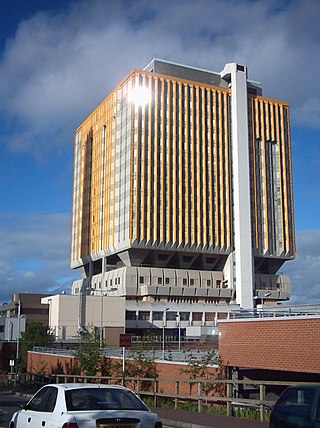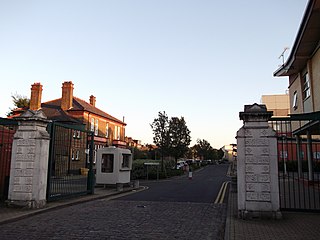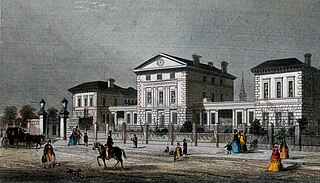
A hospital ship is a ship designated for primary function as a floating medical treatment facility or hospital. Most are operated by the military forces of various countries, as they are intended to be used in or near war zones. In the 19th century, redundant warships were used as moored hospitals for seamen.

The Belfast City Hospital in Belfast, Northern Ireland, is a 900-bed modern university teaching hospital providing local acute services and key regional specialities. Its distinctive orange tower block dominates the Belfast skyline being the third tallest habitable storeyed building in Northern Ireland. It has a focus on the development of regional cancer and renal services. It is managed by Belfast Health and Social Care Trust and is the largest general hospital in the United Kingdom. In April 2020, due to the global coronavirus pandemic, the tower block was designated one of the UK's Nightingale Hospitals.

Highlands Hospital was a hospital in Winchmore Hill, in the London Borough of Enfield which closed in 1993. The site was redeveloped for residential accommodation, although many of the original buildings remain. The site is designated a conservation area and the former ambulance station is a grade II listed building.

HMS Atlas was a 91-gun second rate ship which was never completed and spent her entire service in reserve or as a hospital ship. She was launched in 1860, and lent to the Metropolitan Asylums Board for use as a hospital ship in 1881, and sold to them in 1885. Atlas served until 1904, when she was sold for breaking.

HMS Endymion was a 21-gun Ister-class wooden screw frigate, the third of four ships of this name to serve in the Royal Navy. She was the last wooden frigate built at Deptford Dockyard. She was commissioned in 1866 and spent much of her service based at Malta. In 1869–70 she sailed around the world as part of a Flying Squadron. She remained in front-line service until 1874.

Lambeth Hospital is a mental health facility in Landor Road, South London. It was previously known as the "Landor Road hospital" and is now operated by the South London and Maudsley NHS Foundation Trust and is affiliated with King's College London's Institute of Psychiatry. It is also part of the King's Health Partners academic health science centre and the National Institute for Health and Care Research (NIHR) Biomedical Research Centre for Mental Health.

Castalia[Note A] was a 1,533 GRT twin-hulled paddle steamer that was built in 1874 by the Thames Ironworks and Shipbuilding Company, Leamouth, London for the English Channel Steamship Company. She was acquired by the London, Chatham and Dover Railway (LCDR) in 1878 but had already been laid up by then and was not operated by the LCDR. In 1883, she was sold to the Metropolitan Asylums Board and converted to a hospital ship. She served until 1904 and was scrapped in 1905.

Coldharbour is a street and wider conservation area in Blackwall, lying on the north bank of the River Thames, east of Canary Wharf. The area is said to be "[t]he sole remaining fragment of the old hamlet of Blackwall" and "one of the last examples of the narrow streets which once characterised the river's perimeter".

Heartlands Hospital, formerly EastBirmingham District Hospital, is an acute general hospital in Bordesley Green, Birmingham, England. It is managed by University Hospitals Birmingham NHS Foundation Trust.

Darent Valley Hospital is a 478-bed, acute district general hospital in Dartford, Kent, England. The hospital has an Emergency Department. The hospital is managed by the Dartford and Gravesham NHS Trust.

The Brook General Hospital was the westernmost of three hospitals simultaneously situated on Shooter's Hill in southeast London in the Royal Borough of Greenwich. It closed in 1996, and most of its buildings were subsequently demolished.

Joyce Green, at Long Reach, near Dartford, was one of the first Royal Flying Corps (RFC) airfields. It was established in 1911 by Vickers Limited who used it as an airfield and testing ground. At the outbreak of World War I in 1914, the RFC followed and established a base. Subject to frequent flooding and a reputation as being unsuitable and too dangerous for training, it was eventually replaced by a more suitable site at RAF Biggin Hill.
St James' Hospital was a healthcare facility in Balham, London that existed between 1910 and 1988. The hospital buildings occupied sites within the boundary of Ouseley Road, Sarsfield Road and St James's Drive Balham London SW12.

New Cross Hospital was a hospital in the New Cross district of south east London, open from 1877 until around 1991.
Fulham Hospital was an English hospital in the west London district of Fulham from 1884 to 1973. From 1957 onwards it was merged with the Charing Cross Hospital and was gradually demolished. Charing Cross Hospital relocated from central London and now occupies the former Fulham Hospital site, south of St Dunstan's Road.

Dulwich Community Hospital was a hospital located in Dulwich, in South London.

West Hill Hospital was a health facility in West Hill, Dartford, Kent, England. It was managed by Dartford and Gravesham NHS Trust.

A fever hospital or isolation hospital is a hospital for infectious diseases such as Scarlet fever, Tuberculosis, Lassa fever and Smallpox. Their purpose is to treat affected people while isolating them from the general population. Early examples included the Liverpool Fever Hospital (1801) and the London Fever Hospital (1802). Other examples occurred elsewhere in the British Isles and India.

The Edinburgh City Hospital was a hospital in Colinton, Edinburgh, opened in 1903 for the treatment of infectious diseases. As the pattern of infectious disease changed, the need for in-patients facilities to treat them diminished. While still remaining the regional centre for infectious disease, in the latter half of the 20th century the hospital facilities diversified with specialist units established for respiratory disease, ear, nose and throat surgery, maxillo-facial surgery, care of the elderly and latterly HIV/AIDS. The hospital closed in 1999 and was redeveloped as residential housing, known as Greenbank Village.
Long Reach is a low-lying area north of Dartford, Kent, in southeast England, on the south side of the River Thames, east of Erith and the River Darent. It was the site of a pub, a fireworks factory, a smallpox hospital and, from 1911, a Vickers airfield that later became RAF Joyce Green. It also gives its name to a Thames Water sewage treatment works.


















